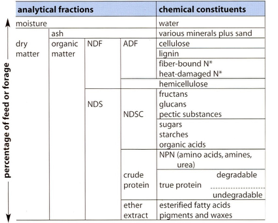
Things that initially appear to be complex often seem simple once they have been explained and are understood. Perhaps a good example is the composition of livestock feeds and forages. Many of the numerous terms used in describing these components are not commonly used by the general public, which naturally causes misunderstandings.
Sometimes a simple table or figure can provide much insight. That is the case with the above figure prepared by Dr. J.E. Moore, Professor Emeritus (retired) in the Animal Sciences Department of the University of Florida.
In this table, the most basic explanation of what a feed or forage consists of is on the left side, and it becomes more detailed as it progresses to the right side. The exact amounts of various components vary in different samples, which is why testing is needed. In this figure, the approximate amounts of the various components are shown by the vertical heights of each segment.
The first basic consideration of the composition of a feed and forage is that it consists of dry matter and moisture. As indicated on the left side of the figure, the amount of dry matter far exceeds the amount of moisture (at least in most samples of hay or other dry feed material).
The next consideration is the amount of ash (inorganic materials) and organic matter present within the dry matter. Ash can be described as what would be left if all of the organic matter was burned away. As shown, organic matter comprises the vast majority of the dry matter in a feed or forage sample.
After that, the relative amounts of NDF (Neutral Detergent Fiber) versus NDS (Neutral Detergent Solubles) within the organic matter is provided. NDF represents the indigestible as well as the slowly digestible components in cell walls. NDS refers to the organic matter components that are mostly quite digestible. There is a negative relationship between NDF and animal intake of a feed or forage.
NDF consists of ADF (Acid Detergent Fiber) and hemicellulose. ADF refers to the highly indigestible components of a feed material (mainly cellulose and lignin. Hemicellulose, which is comprised of long chains of sugar compounds, is partially digestible.
NDS is the portion of a sample that is especially valuable in animal nutrition. It includes NDSC (Neutral Detergent Soluble Carbohydrates), which consists of various types of carbohydrates, crude protein, and what is referred to by laboratory workers as ether extract. Crude protein, not all of which is digestible, is the nitrogen-containing components of a food or forage. Either extract refers to miscellaneous other digestible constituents. The remaining portion of the table (the right side) reveals the chemical components within the various analytical fractions discussed. These should be easily understandable and thus don’t justify additional explanation.
Most forage-livestock producers don’t need to know the definitions of all of these terms. But having a general understanding of the analytical fractions within a feed or forage sample is desirable. This figure does a good job of illustrating how these components are related.

___________
Foraging Ahead is a column presented by Ragan & Massey and written by Dr. Don Ball, Professor Emeritus at Auburn University. Dr. Ball is one of the authors of the popular book “Southern Forages.”
